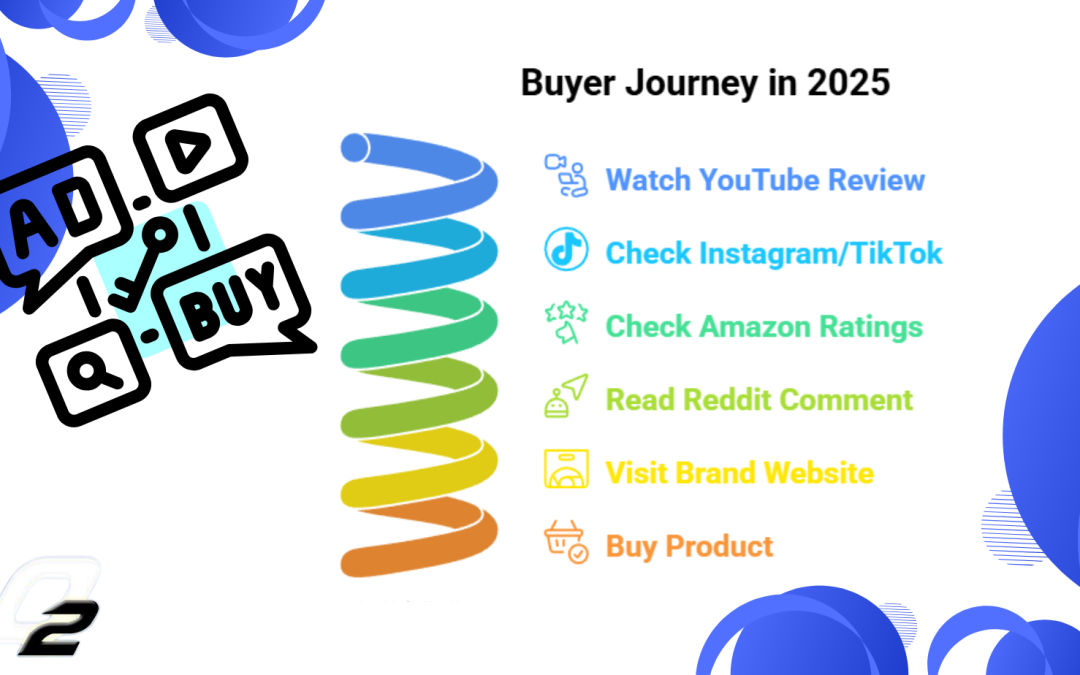
by Shashikanth Heerekar | Dec 11, 2025 | All Things about Marketing, Digital Marketing, SEO News, Technology
When I talk about “Search Everywhere Optimization,” I am simply talking about how people search today. Years ago, most users depended only on Google. But now, people don’t stay on one platform. They move from one place to another before making any decision.
This is why I believe Search Everywhere Optimization is not just a trend; it is the new reality of how buyers behave.
Let me explain this in a very simple and casual way, just how I explain it to my clients.
Why Search Everywhere Is Very Important
People don’t trust only one platform anymore.
Today, users follow a long journey before they buy anything.
They might start on Google, then move to others, or they might find it on any platform and then move to other platforms.
- YouTube
- Instagram
- TikTok
- Reddit
- Quora
- Amazon
- Product review sites
- Social media posts
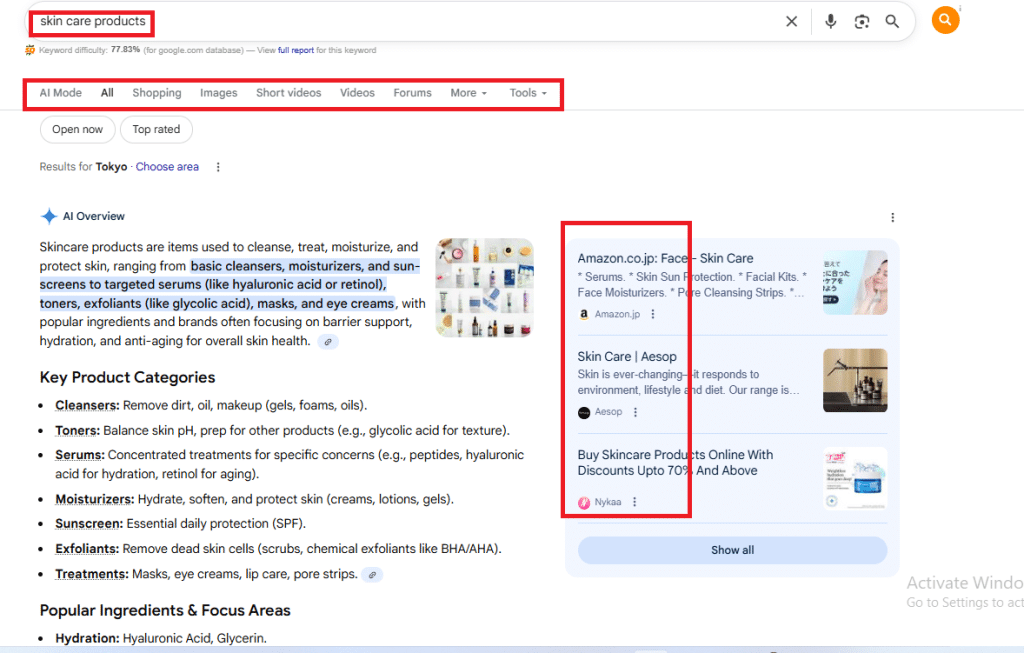
A buyer is not “searching once.”
A buyer is searching everywhere.
Let’s take a simple example:
Someone wants to buy a skincare product. For an instant I was scrolling YouTube last night, and somewhere in my mind I was also looking for skincare products. Suddenly, I found a video on YouTube Shorts related to skin care on that platform. I got interested and curious to know more about that product. So, I started switching to another platform where I can learn more about the product. Now I try to search for that product on every platform, like I will watch videos related to how to use it, check the reviews on forums, and check the rating, then I’ll visit the affiliate market and search for the product, and then I decide to purchase or not.
- First, they watch a YouTube review.
- Then they check Instagram Reels or TikTok videos.
- Following that, they check Amazon ratings.
- In sequence to the above, they read a Reddit comment.
- Only after all this do they visit the brand website.
- Then they buy.
Let’s look at the real-time examples below and how they did branding related to their product and also never left any platform marketing or branding their product; just have a look.
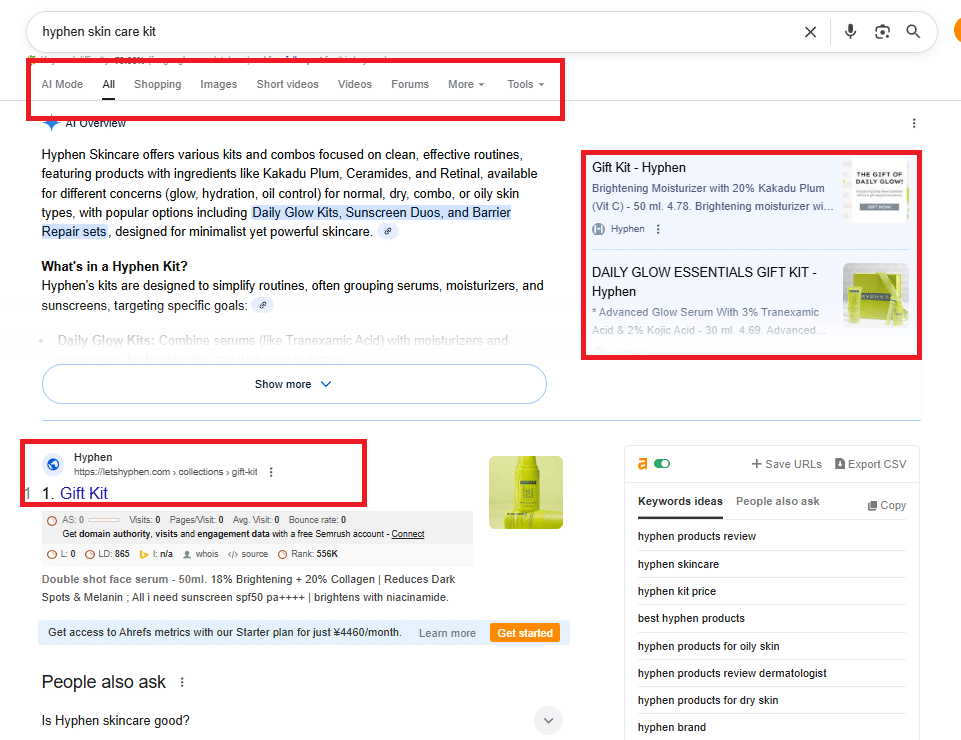
Video review for branding
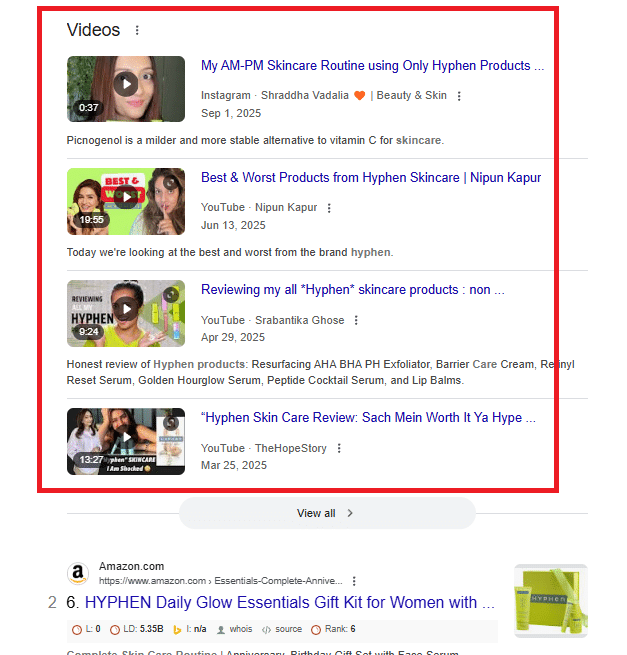
Selling this product on every affiliate platform makes it very convenient for the buyer.

They have also had news articles related to the product and how strong they have built their branding.

This is a real buyer journey in 2025.
Here are simple stats that prove this behavior:
| User Behavior |
Percentage |
| People who watch YouTube before buying |
68%+ |
| People who search social media for ideas |
55%+ |
| People who depend on Amazon reviews and also look for real photos |
84%+ |
| People who check forums like Reddit/Quora |
35%+ |
This is exactly why Search Everywhere Optimization is important.
If buyers are everywhere, I also need to make sure the brand appears everywhere.
To Whom Search Everywhere Optimization Is Important
I recommend this approach to almost every industry, but some need it more and also some not at the start; I recommend them to stick to SEO services before using these services.
1. E-commerce brands
People compare everything: reviews, videos, social posts, and prices.
2. Local businesses
They check Google Maps, Instagram photos, Facebook comments, and ratings.
3. Service-based companies
A user checks your website, your LinkedIn, your reviews, and your social presence.
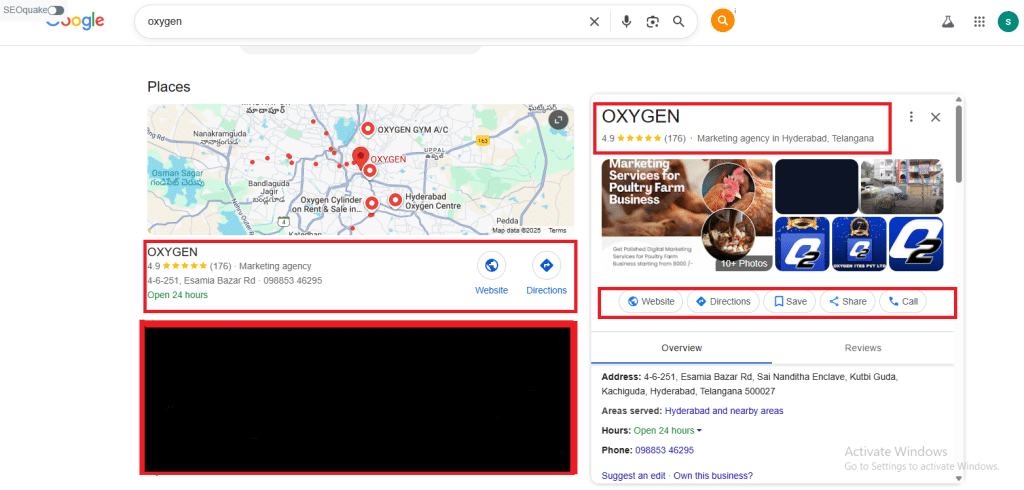
We can see in the above oxygen company how Google is providing reviews, ratings, and also how to visit the company.
4. Coaches, trainers, educators
A lot of discovery happens on YouTube Shorts, TikTok, and Instagram.
5. B2B companies
Buyers search across Google, LinkedIn, industry forums, and comparison sites.
In short, if your customers search on multiple platforms, then Search Everywhere Optimization is important for you.
Why Google SEO Alone Is Not Enough
I work in SEO, so I know how important Google is.
But the truth is very simple:
Google is only one part of the buyer’s journey now.
Let’s say someone is searching for a laptop.
They don’t just read one Google blog and buy.
They watch videos, check Reddit discussions, read Amazon reviews, and look at user feedback everywhere.
If your brand appears only on Google, you miss the entire journey where decisions are actually happening.
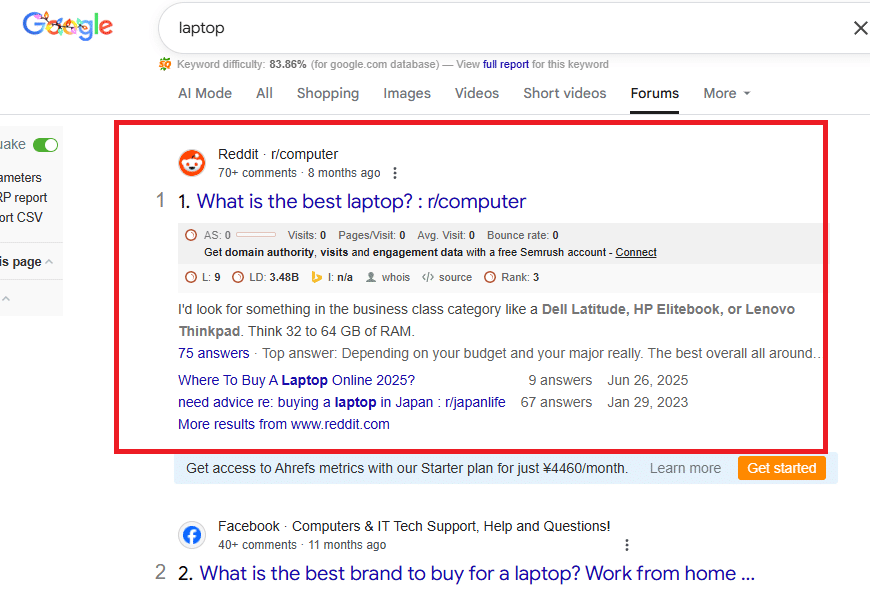
Difference Between SEO and Search Everywhere Optimization
I explain this difference to my clients using a simple table:
| Feature |
Traditional SEO |
Search Everywhere Optimization |
| Focus |
Only Google |
All platforms customers use |
| Content Type |
Blogs & web pages |
Videos, shorts, posts, reviews, forums |
| Journey |
Straight line |
Multi-step, multi-platform |
| Buyer Mindset |
“Search on Google” |
“Search everywhere before trust” |
| Visibility |
One place |
Every place that matters |
A very simple way to understand:
SEO is one channel. Search Everywhere is the full buyer journey.
Is Traditional SEO Dead?
No, traditional SEO is never going to die.
But it is no longer enough by itself.
Here’s what I usually tell people:
✔ SEO is still important
✔ Google is still the biggest search engine
✔ But people don’t stop at Google anymore
So SEO is not dead; it has simply grown into something bigger.
Conclusion
Search Everywhere Optimization is not a complicated idea. It simply matches the way people search today. Buyers move from Google to YouTube to Instagram to Reddit to Amazon and then to your website.
If you want trust, visibility, and actual conversions, you need to be present everywhere your buyer goes, not just on Google.
This is how the real buyer journey works now, and this is why I strongly believe Search Everywhere Optimization is the future of digital visibility.

by Shashikanth Heerekar | Nov 22, 2025 | Digital Marketing, SEO News
Improve your
search engine positioning in India with proven strategies, ranking factors, common pitfalls, and expert insights. Boost visibility, authority, and long-term online growth.
Introduction
Search engine positioning plays a vital role in determining how easily your business is discovered online. In a fast-growing digital market like India, visibility can directly influence credibility, customer trust, and competitive advantage. When your website appears in strong positions for targeted searches, it attracts more traffic without paid promotions. Understanding search engine positioning helps you build smarter strategies that improve reach, engagement, and long-term online growth.
The Fundamentals of Search Engine Positioning: Key Concepts and Terminology
Search engine positioning revolves around how prominently your website appears for specific search queries. To understand it clearly, it’s important to explore the foundational concepts that guide ranking and visibility on platforms like Google, Bing, and emerging AI-driven search tools.
1. Search Intent
Search intent reflects the purpose behind a user’s query—whether they want information, directions, comparisons, or services. In India’s diverse digital environment, understanding intent is crucial because users rely heavily on search engines for quick solutions. When your content addresses the exact intent behind a query, search engines reward your page with better placement.
2. Content Relevance and Quality
Content relevance is determined by how well your page answers a user’s query. High-quality content is clear, original, and helpful. It uses simple language, accurate information, and organized formatting. Search engines recognize when your content genuinely helps users, and they prioritize such pages. In India’s competitive online sectors—like education, healthcare, and e-commerce—quality becomes a major differentiator.
3. Keyword Optimization
Keywords help search engines understand context. Effective optimization requires naturally integrating keywords into titles, headers, and the content body without stuffing. India-specific long-tail keywords, local dialect variations, and regional search patterns can also play a significant role in increasing visibility and relevance.
4. Authority and Trust Signals
Authority is built through credible backlinks, consistent updates, and trustworthy information. Indian users often search for dependable sources before making decisions, so websites with strong authority perform better. Search engines measure trust through site security, accuracy, and external validation. The stronger your credibility, the more likely your website will secure prominent positioning.
Analyzing the Current Landscape of Search Engine Positioning
The search engine positioning landscape in India is evolving rapidly due to rising internet adoption, mobile-first usage, and increasing reliance on digital solutions. India’s digital audience spans multiple languages, regions, and browsing habits, making the environment more dynamic than many global markets. As users turn to search engines for everyday needs, brands face growing competition for visibility.
Smartphones dominate India’s online activity, which makes mobile performance a crucial factor in search visibility. Google’s mobile-first indexing prioritizes websites that load quickly, adapt to different screen sizes, and provide smooth navigation. Pages that fail to meet these basic expectations lose visibility even if their content is strong.
Artificial intelligence and machine learning have significantly changed how search results are ranked. Search engines now understand conversational queries, local nuances, and contextual relationships between topics. This means that content must be more natural, more specific, and more engaging. Traditional SEO tactics alone are no longer enough to stay competitive in India’s search environment.
Additionally, competition has intensified across industries like finance, healthcare, education, real estate, and local services. Many Indian businesses are investing heavily in digital marketing, making search engine positioning more challenging. To stand out, websites must not only provide valuable content but also optimize technical performance and user experience.
The rise of voice search in India, fueled by affordable devices and multilingual support, adds another layer of complexity. Users increasingly rely on voice commands in English and regional languages. This shift demands more conversational and intent-driven content to align with how people naturally speak.
Overall, India’s search positioning landscape demands adaptability. Businesses that adjust to changing behaviors, update their content regularly, and focus on user-centered performance will see stronger, more sustainable search visibility.
Critical Factors Influencing Search Engine Rankings
1. Content Relevance and Depth
Search engines prioritize content that thoroughly answers user questions. In India, where users come from varied backgrounds and information needs, clarity and depth matter greatly. Detailed explanations, practical insights, and structured content show value and expertise. Such pages keep users engaged longer, signaling strong relevance to search engines.
2. Website Performance and User Experience
Fast performance is essential, especially in India, where internet speeds vary across regions. Websites that load quickly, work flawlessly on mobile devices, and offer smooth navigation tend to rank higher. Search engines monitor bounce rates, session duration, and interaction levels to understand user experience. A well-optimized, responsive website encourages users to stay longer and explore more content.
3. Backlinks and Domain Authority
Backlinks remain one of the strongest ranking signals. When trusted Indian or international websites link to your content, it enhances your authority. Search engines value high-quality, relevant links over sheer quantity. Strong domain authority reflects credibility, expertise, and trustworthiness. Earning backlinks through original research, helpful articles, and digital PR strengthens your overall ranking potential.
Proven Strategies for Enhancing Your Search Engine Positioning
Boosting your
search engine positioning requires a balanced mix of content strategy, technical improvements, and user-centered optimization. Begin by researching the keywords and phrases Indian users commonly search for in your industry. Use these terms naturally throughout your pages while keeping your writing helpful and readable.
Refreshing older content is another powerful strategy. Many Indian users search for updated information, especially in niches like finance, travel, and technology. Updating outdated sections, adding local examples, and incorporating new statistics help keep your content relevant. Search engines prefer websites that remain active and useful.
Technical enhancements also play a major role. Focus on improving load speed, optimizing images, compressing files, and ensuring mobile responsiveness. In India, where a significant portion of users browse on mid-range smartphones and variable network speeds, fast performance directly influences search visibility.
Strengthening your website’s authority is equally important. Earning high-quality backlinks from reputable Indian websites, blogs, or media outlets increases trust. Engaging in collaborations, guest posts, and industry discussions helps your website grow in recognition. Publishing unique insights or data makes your content more link-worthy.
Finally, regularly track your performance through analytics tools. Observing patterns in user behavior, traffic sources, bounce rates, and ranking changes helps you adjust your strategy. Search trends evolve quickly in India, so staying informed and flexible ensures long-term success. A consistent, well-rounded approach to content, performance, and authority builds a strong foundation for high search engine positioning.
Common Pitfalls to Avoid in Search Engine Positioning
1. Keyword Stuffing
Overloading your content with keywords disrupts readability and may lead to penalties. Users in India expect natural, helpful writing, and search engines now recognize when keywords feel forced. Focusing on clarity and value always produces better results.
2. Ignoring Mobile Optimization
With the majority of Indian users browsing on smartphones, poor mobile optimization can severely hurt rankings. Slow loading times, broken layouts, or complicated navigation push users away and signal poor quality to search engines.
3. Publishing Thin or Low-Value Content
Short, generic, or repetitive content rarely performs well. Users want clear explanations, practical advice, and trustworthy information. Shallow content sends negative engagement signals and limits your visibility.
4. Neglecting Technical SEO
Missing metadata, broken links, slow speeds, and unoptimized images all weaken your ranking potential. Technical
SEO services ensures your website is fully accessible and easy for search engines to evaluate.
5. Overlooking Backlink Quality
Not all backlinks help. Low-quality or spammy links can harm your reputation. Search engines prefer a few strong, relevant links over hundreds of weak ones. Focus on earning links from credible Indian and global websites.
6. Failing to Monitor Performance Metrics
Without regular analysis, it’s impossible to understand what’s working. Many websites lose positioning simply because they ignore trends, ranking changes, and shifting user behavior. Tracking performance ensures steady progress and timely adjustments.
Conclusion
Strengthening your search engine positioning in India requires a blend of relevant content, strong performance, and credible authority. When you focus on delivering genuine value and enhancing user experience, your website becomes more visible and trustworthy. Consistency, adaptability, and strategic refinement help you stand out in a competitive digital landscape and build long-term online success.
FAQs
1. What does search engine positioning mean for Indian businesses?
Search engine positioning refers to where your website appears in search results when Indian users search for specific terms. A higher position means more visibility, traffic, and trust. Since most buyers in India research online before making decisions, strong positioning helps you stand out and reach your audience more effectively.
2. How long does it take to improve my website’s ranking in India?
Improvement timelines vary depending on competition, industry, and your current website health. Generally, noticeable progress can take a few weeks to a few months. Consistent updates, quality content, technical optimization, and strong backlinks accelerate growth. Patience and ongoing effort are key to achieving stable, long-term visibility.
3. Do backlinks matter for rankings in India?
Yes, backlinks remain very important. When trusted Indian or global websites link to your content, it tells search engines that your information is credible. High-quality backlinks improve your authority and boost your chances of ranking higher. Focus on earning natural, meaningful links rather than collecting large numbers of weak ones.
4. Why is mobile optimization so critical for Indian websites?
India has one of the world’s largest mobile-user populations. Most people browse the internet on smartphones, so a website that loads slowly or performs poorly on mobile devices loses engagement quickly. Search engines prioritize mobile-friendly sites, making optimization essential for stronger rankings and better user experience.
5. How can I maintain long-term search engine visibility?
Long-term visibility comes from consistency. Regularly update your content, track performance, improve technical health, and continue building authority through quality backlinks. Stay aware of changing search trends in India and adjust your strategy accordingly. With steady effort, your rankings will grow and remain stable.
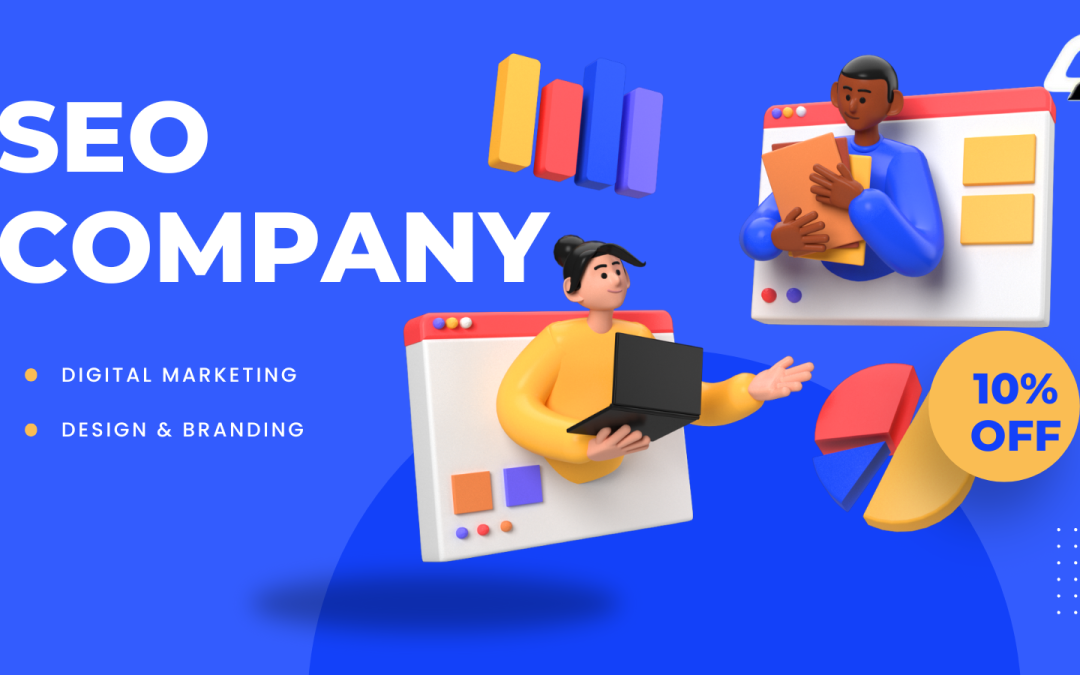
by Shashikanth Heerekar | Nov 15, 2025 | Digital Marketing, SEO News
Partner with an SEO company that provides measurable results. Increase rankings, engagement, and scale your business with ease.
Introduction
In today’s highly competitive digital landscape, it makes strategic sense for global brands to hire an Indian
SEO company. With the growth of the Indian SEO market, skilled SEO professionals based in India, and cost-effective pricing models, companies from around the world are looking to utilise SEO companies in India as a way to scale more quickly and effectively. From startups to global companies, Indian SEO companies have a reputation for achieving measurable, long-lasting digital growth.
The Current Offering of SEO Services by Indian Companies
The landscape of SEO firms in India in the past decade has changed drastically. Nowadays, with the growth of digital marketing, Indian SEO companies offer seamless, high-impact services in tactical, strategic, and technical delivery based on a variety of industries. Let us take a look at the key services offered by prominent Indian SEO firms that demonstrate why they are in the unique position of being globally competitive.
Thorough Optimization Services for Web Pages
Most Indian SEO companies put a huge focus on on-page SEO- they are the cornerstone of any SEO undertaking in India. On-page entails optimizing keywords, creating meta-tags, improving site structure, and ensuring topic relevance. With these keywords and values in place, websites communicate with search engines more efficiently, which leads to greater visibility. The best SEO company in India also uses tools like Ahrefs and SEMrush to examine competitors and improve the on-page strategy to ensure every page has been optimized for search visibility and engagement.
Strong Off-page and Link-building Technique
Off-page SEO is where Indian SEO agencies shine. They also implement genuine link-building campaigns, guest posting, influencer outreach, and social bookmarking- all aimed at building domain authority and referral traffic. Unlike the best SEO (optimization) companies in India, which often focus on the quality of links rather than pure quantity, ensuring keywords are being re-ranked is not immediate and sometimes shaky. However, some of the top SEO agencies in India have gone so far as to try to go their way into constructing organic link networks with niche-specific bloggers and content publishers to advance visibility at a global scale.
Website SEO and Technical Audit
The best SEO companies based in India typically do a technical audit, which entails digging deeper into the backend issues. The work of technical webmasters can range from simply fixing crawl errors to making sure that the site’s pages load faster, but technical SEO mainly prioritizes a better user experience. An SEO or content marketing agency in India will therefore enhance webpage speed, mobile responsiveness, and address issues with broken and dead links. They will also review security measures like implementing HTTPS. Making these types of technical improvements ensures that search engines can efficiently crawl, index, and rank pages, and essentially are laying the groundwork for the digital foundation of a Website.
Content Marketing and Keyword Mapping
Also, you’ll find that a solid, carefully crafted content strategy helps differentiate Indian-based SEO experts. SEO and Content professionals typically approach SEO and Content from a standpoint of sophisticated storytelling, evolving content that will rank and resonate with audiences. Using keyword mapping, developing strategies, and competition trend analysis, an SEO service company based in India will make the case to you regarding how every piece will lead to conversions. Whatever form of content you decide to produce, whether blog posts, product descriptions, landing pages, etc., a competent SEO service in India will produce content in line with brand goals and user intent (to generate visits!), thereby pushing the site up in the search results.
Key Benefits of Partnering with an Indian SEO Company for Global Clients
Partnering with an SEO company in India offers a distinctive mix of price, professionalism, and creativity. Indian SEO firms have become global leaders in providing stellar SEO results for clients worldwide over the years. Let’s explore the key benefits of hiring an Indian SEO firm, or an SEO company in India, for your brand’s online success.
Cost-effectiveness is arguably one of the biggest benefits. SEO services in India are much more affordable than in Western markets without sacrificing quality. This can allow startups and small businesses to compete globally. An SEO Agency in India can achieve the same or better results at a fraction of the cost of the same service in the West. This economic pricing has made India a favored destination for worldwide outsourcing of SEO services.
Another advantage is that some of the greatest Indian SEO experts or SEO consultants in India are found within its borders. The SEO professionals know SEO algorithms, analytics, and trends in online marketing and provide targeted strategies that lead to measurable results. Whether on-page, content marketing, or technical SEO, the top SEO in India graduate SEO professionals have been tested and priced in every area. Many global brands trust Indian SEO because they
Another advantage is 24/7 worldwide communication and service. SEO service companies in India’s time zones allow for around-the-clock availability and provide assurance that your campaigns never slow down. The responsiveness allows for seamless communication and quicker turnaround times. The better SEO companies in India will often assign an account manager to international clients to maintain transparency and ease.
On top of that, Indian SEO agencies mix creativity with actionable data-driven intelligence. By leveraging advanced analytics and AI-based SEO tools, the SEO companies in India customize campaigns specific to your brand’s niche. They are not just concerned with rankings— they are concerned with ROI. The top SEO companies in India employ conversion optimization, lead generation, and user experience improvements to turn clicks into loyal customers.
In conclusion, Indian SEO companies provide global standard expertise, cheap executions, and dependable communication all under one partner. Those policies have helped explain the backbone of digital success for thousands of their clients globally for a while now.
Key SEO Strategies Utilized by the Leading SEO Firms in India
The best SEO agencies in India do not simply rely on conventional practices. They use uniquely devised and data-driven approaches to produce reliable results. The SEO optimization companies in India combine creative, analytical, and technology-oriented campaigns so brands can achieve high performance on search result pages. Here is a synopsis of the highlights of each of these highly sought-after SEO companies from India.
Ethical Practices for Sustainable SEO
Trustworthy SEO firms in India apply an ethical – or white hat SEO – approach to SEO practices that align with policies and guidelines. They avoid mechanisms like link spamming and keyword stuffing. They continue to emphasize building website authority using relevant backlinking, real content, and audience engagement. For example, the best SEO services in India appreciate that long-term rankings are mostly about building consumer trust with search engines. They specialize in helping companies grow sustainably over time while adhering to Google-approved processes on a global scale.
Keyword Research and Analytics Based on Data
A significant factor of SEO success is identifying keywords that are appropriate. Indian SEO companies use advanced keyword research tools like Google Keyword Planner, SEMrush, and Ahrefs to identify opportunities. They categorize keyword phrases according to user intent (informational, navigational, or transactional). The best SEO service company in India structures and conducts campaigns with respect to user intent in the search engine results, reaching both local customers as well as a global audience. By leveraging data and reasoned planning of keywords, Indian SEO experts are confident that every post or information they assemble has the potential to attract organic traffic and generate conversions.
Integrating Local and Global SEO
Another important strategy that Indian SEO companies adopt is the strategy of integrating local SEO and global SEO strategies. Whether you are a small local business in New York or a global brand of eCommerce, SEO companies in India will effectively optimize your website both for local phrases (for example, best seo firm near me?) and global keyword demands as needed. The best SEO agencies in India will create Google My Business profiles, build citations for the client, and identify a multilingual audience. The combination of both local and global keyword strategies allows a relative dominance of search results, resulting in increased visibility and market share around the globe.
Once again, armed with innovation and precision, in the digital context, every SEO company in India is globally positioned to provide value.
Common Challenges When Working with an Indian SEO Company and Solutions
While there are plenty of benefits to partnering with an SEO agency in India, there may be challenges in collaborating, regardless of the international client’s size. Luckily, any challenges are simple to work around when you choose the right
SEO company in India that values communication and professionalism. Here are some common hurdles, and how to get things accomplished:
The first big challenge for international clients is the communication barrier. Between time zone differences and language in some situations, you may find it challenging to have a smooth project communication system. Fortunately, the best SEO companies in India have already dealt with this, developing an exceptional customer service model – 24-hour customer support! Most professional SEO companies also have assigned account managers who will reach out to you each week via email to touch base, report on your progress, and/or discuss updates on your website. These companies will also offer you digital communication tools (such as SLACK, TRELLO, or ZOOM) that will allow you to collaborate in real time, opening up the line of communication.
The second challenge may be quality. There are many can companies available in India that can provide great SEO optimization; however, they are not all created equal. Not all SEO companies will use white hat techniques to manage your company’s website activity, but reassuringly, there are SEO companies that will engage in black-hat methodologies.
There is also the matter of cultural and market knowledge. International clients may be concerned that an SEO company from India may not understand the buyer persona of their specific market. The best SEO agency in India readily solves this by performing extensive audience research and analytics to create content that is relevant to all target markets as a global company. Indian SEO experts perform in-depth competitor analysis and user intent modeling, as well as demographic study to develop their campaigns.
Additionally, some clients may be concerned about data transparency in reporting and analytics. Less-reputable SEO service companies in India, particularly smaller or newer companies, may just provide a low-level overview of the performance of campaigns. To solve for this, trustworthy SEO companies in India provide clients with real-time SEO dashboards and monthly performance reports documenting their keyword rankings, organic traffic, and return on investment metrics.
Finally, the timeframe expectation is often where misunderstandings arise. SEO is a long-term and sustainable work stream, but clients may expect some form of gratification in an unreasonable timeframe. The best SEO agencies in India work to educate their clients about realistic timeframes for growth. They ultimately understand that their main goal is to generate the best possible results in a shifting marketplace, so they prioritize sustainable, longer-term ranking growth instead of shoot-from-the-hip quick wins for clients.
In short, while there may be a few challenges working with an SEO company located in India, reputable companies will turn those challenges into opportunities. When you have an open line of communication while also employing transparent planning of your SEO growth strategy, in a landscape that changes frequently, trust becomes paramount. Consistent check-ins with a reputable SEO in India ensure a strong foundation for long-term online success.
Case Study: Attaining Online Growth with an Indian SEO Company
Real-world success stories demonstrate the exact way in which an Indian SEO company can fundamentally shift the online trajectory of your brand. This case study will talk about how an SEO company in India set the groundwork and ultimately earned significant outcomes for a global eCommerce client through implementing sound SEO.
The Client Information and Business Disposition
The client was a mid-sized eCommerce brand in the United States suffering from a lack of organic traffic and visibility. After extensively researching several of the top SEO agencies in being in India, the client decided to partner with an SEO company in India that was known for their affordability and effectiveness.
The SEO Challenge Faced by the Client’s Business
It was before the client reached out to SEO experts in India that the client’s website had poor keyword targeting, low-value backlinks, slow load, and visibility in search engines. The client attempted ads and could not achieve organic growth. The client was seeking a flexible SEO company with the additional expertise to develop a long-term term sustainable SEO plan.
Customized SEO Strategy from the Indian SEO Company
The SEO agency located in India started with a website audit to identify any technical issues, keyword gaps, and possibilities. Their strategy included on-page optimization, building backlinks with high authority, and improving the performance of user engagement. They also constructed a robust content marketing strategy to guarantee that every blog and product page targeted the right, relevant, high-intent keywords.
Execution
Over the ensuing six months, the Indian SEO agency executed a number of different strategies, including website restructuring, schema markup, and writing content based on keywords. Meanwhile, their off-page team developed relationships with niche publishers to build natural backlinks. The Indian SEO agency ensured that all the work continued to be compliant with algorithm updates from Google, keeping the technical, white-hat optimization.
Overall Performance Metrics
Within six months, the client’s organic traffic grew by more than 160%, and top keywords ranked in the top 10 positions on Google. Their sales grew by 90%, and their website domain authority increased from 24 to 45. The client indicated significant ROI, confirming that SEO services from India have led to real, sustainable results.
Final Thoughts
This case demonstrates that the right SEO service agency in India will totally change a company’s online performance. The mix of technical, content
Conclusion
Partnering with an Indian SEO company means more than just outsourcing—it’s about forming a strategic alliance that transforms your digital footprint. The right SEO firm in India can help your business achieve higher rankings, better visibility, and stronger ROI. Choose wisely, and your online growth will speak for itself.
FAQs
1. Why should I hire an Indian SEO company for my business?
When you choose an SEO firm from India, you benefit from global expertise at a fraction of what you would pay elsewhere. The best SEO firms in India rely on data-driven approaches, creativity, and industry experience to improve search rankings. On your part, the scalability, 24/7 support, and proven results make these firms the perfect partner for any business looking for sustainable results on a global scale.
2. How do Indian SEO experts guarantee long-term SEO success?
In India, SEO experts rely on white-hat SEO techniques, keyword research, link-building, and precise analytics to guarantee long-term success. The best SEO agencies in India continuously adjust to algorithm updates, focusing on bringing authority and trust to the various websites they work with. Their goal is not to get a few quick hits, but rather consistent long-term visibility for your brand.
3. Are SEO services in India cheap yet effective?
Yes! SEO services in India are viewed as affordable and performance-based. The top SEO service company in India provides the same quality and, in many respects, they are equal to that from the Western agencies; however, you are paying a fraction of the cost. All while getting the biggest bang for your buck with no professionalism or results compromised.
4. How do I find the best SEO company in India for my business?
If you want to know how to find the best SEO company in India, consider looking at client reviews, going through the portfolio, and looking for transparency. Some of the top SEO companies in India, like SEO Yodha etc., have demonstrated their track record of achieving global results through ethical SEO and their metrics of growth that are measurable.
5. Can an Indian SEO company manage International SEO?
Yes totally! Some of the top SEO companies in India also manage local and global SEO. They put together strategies to target an international audience, optimize in multiple languages, and gain rankings globally. It doesn’t matter if your audience is moved to the USA, UK, or Asia, you will be covered with an Indian SEO company.
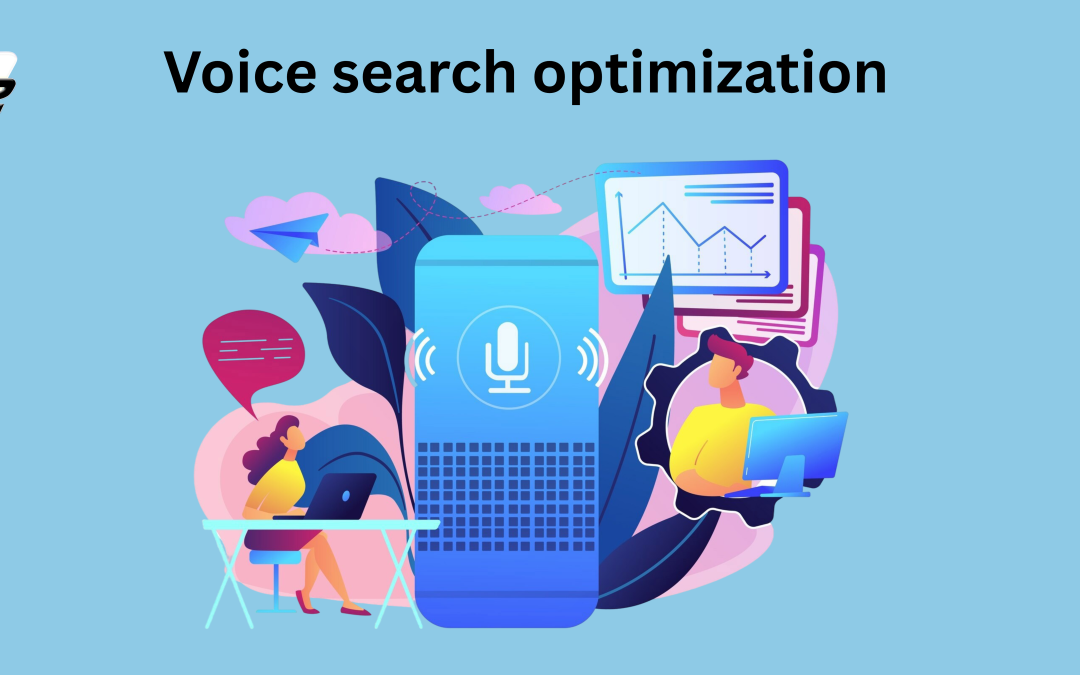
by Shashikanth Heerekar | Oct 11, 2025 | All Things about Marketing, Artificial intelligence, Digital Marketing, SEO News, Technology
Learn how voice search optimization can boost your website traffic and visibility. Discover strategies for local SEO, mobile optimization, and featured snippets to stay ahead in digital marketing.
How To Use Voice Search Optimization To Get More Traffic
I believe the key to driving more traffic with voice search is speaking your audience’s language. Voice searches are conversational and often phrased as questions, like “What are the best coffee shops near me?” rather than short keywords. By writing content that mirrors this natural speech, you increase the chances of being discovered.
Targeting local searches is equally important. Most voice searches have local intent, so keeping your business’s name, address, and phone number consistent across Google Business Profile and directories helps attract nearby customers. Including location-specific phrases naturally within your content also boosts visibility.
I also focus on mobile optimization, as most voice searches occur on smartphones. Fast-loading, responsive websites with clear navigation enhance user experience and improve rankings. Featured snippets are another goldmine: concise, direct answers make it more likely that voice assistants will read your content aloud.
Finally, I constantly analyze and tweak my strategy. Tracking which conversational keywords drive traffic allows me to refine my content and stay ahead. Combining conversational content, long-tail keywords, local focus, mobile optimization, and snippet targeting ensures I get more relevant traffic through voice search.
What is voice search optimization?
Voice search optimization is the process of tailoring your digital content to align with voice-based search queries. Unlike traditional text searches, voice searches are more conversational and often longer. For instance, a user might say, “What are the best Italian restaurants near me?” instead of typing “best Italian restaurants.” Recognizing this shift is crucial for businesses aiming to enhance their online visibility.
How does voice search work?
Voice search operates through voice recognition technology, which converts spoken words into text. This text is then processed by search engines to provide relevant results. The accuracy and efficiency of voice search have improved significantly with advancements in artificial intelligence and natural language processing.
Why optimize for voice search?
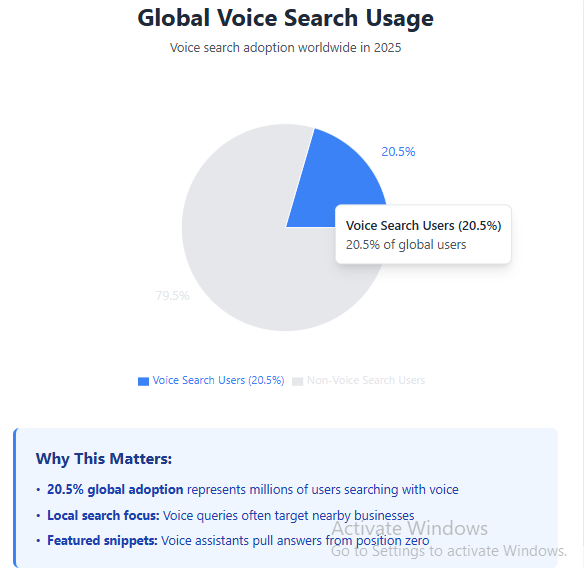
Global Voice search Optimization
Optimizing for voice search is becoming increasingly important in digital marketing for several reasons:
- Increased Usage: As of 2025, approximately 20.5% of people globally use voice search, indicating a growing trend towards voice-based queries.
- Local Search Relevance: Voice searches often have local intent, with users seeking nearby businesses or services.
- Featured Snippets: Voice assistants frequently pull answers from featured snippets, making it essential for businesses to optimize their content for these positions.
Voice Search Statistics 2025 (Key Highlights)
- Around 20.5% of people worldwide use voice search.
- Around 8.4 billion voice assistants are expected to be in use globally.
- In the United States, 153.5 million people are expected to use voice assistants.
- Siri has 86.5 million users in the United States.
- Approximately 27% of people use voice search on their mobile devices.
- In the U.S., 38.8 million people (13.6% of the population) use smart speakers for shopping-related activities.
- “Near me” and local searches make up 76% of voice searches and are expected to grow as more people use voice search to find local businesses.
How to optimize for voice search
Use a conversational tone
When creating content, adopt a natural, conversational tone. This approach mirrors the way people speak, making it more likely that your content will match voice search queries. For example, instead of stating, “Our restaurant offers a variety of Italian dishes,” say, “What Italian dishes do you offer?”
Include more long-tail keywords
Voice searches tend to be longer and more specific. Incorporating long-tail keywords that reflect natural language can improve your chances of appearing in voice search results. For instance, instead of targeting “Italian restaurant,” aim for “best Italian restaurant with outdoor seating in downtown.”
Target local searches
Since many voice searches are location-based, it’s vital to optimize your content for local SEO. Ensure your business’s name, address, and phone number (NAP) are consistent across all platforms. Additionally, include location-specific keywords in your content to attract local customers.
Optimize your site for mobile search.
Mobile devices account for a sizable percentage of voice searches. Therefore, ensuring your website is mobile-friendly is essential. This includes having a responsive design, fast loading times, and easy navigation.
Earn featured snippets
Featured snippets are concise answers displayed at the top of search results. To increase your chances of being featured, provide clear and direct answers to common questions related to your business. Use structured data to help search engines understand your content better.
Flowchart: Steps to Optimize for Voice Search
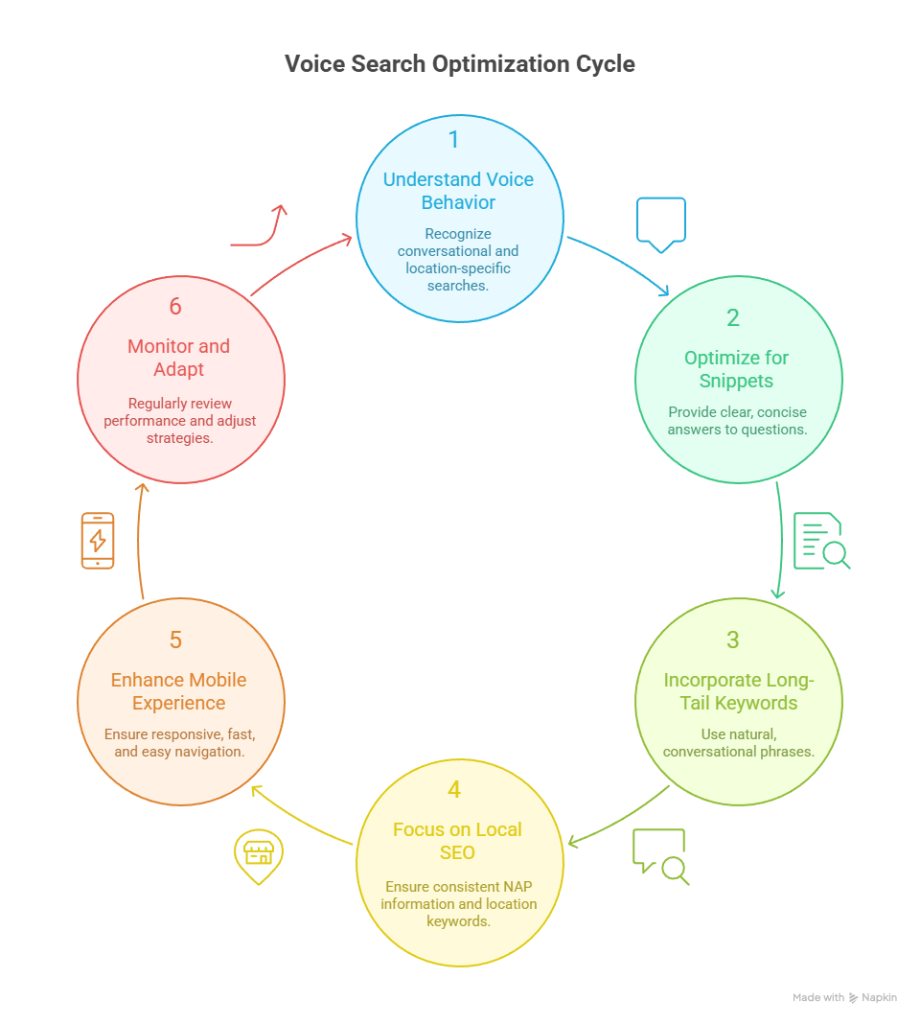
Flowchart: Steps to Optimize for Voice Search – visual selection
- Understand Voice Search Behavior: Recognize that voice searches are conversational and often location-specific.
- Optimize Content for Featured Snippets: Provide clear, concise answers to common questions.
- Incorporate Long-Tail Keywords: Use natural, conversational phrases that reflect how people speak.
- Focus on Local SEO: Ensure your business’s NAP information is consistent and includes location-specific keywords.
- Enhance Mobile User Experience: Ensure your website is responsive, fast, and easy to navigate.
- Monitor and Adapt: Regularly review your voice search performance and make necessary adjustments.
How Do I Optimize My Business for Voice Search?
To effectively optimize your business for voice search, it’s essential to focus on several key areas:
- Claim and Optimize Your Google Business Profile: Ensure your business information is accurate and up-to-date. This includes your name, address, phone number, business hours, and services offered. A well-maintained profile enhances your visibility in local voice search results.
- Incorporate Conversational Keywords: Voice searches are typically more conversational and longer than typed queries. For instance, instead of targeting “best pizza,” aim for “What are the best pizza places near me?” Integrate these natural language phrases into your content to align with voice search patterns.
- Focus on Local SEO: Many voice searches have local intent. Ensure your website includes location-specific keywords and that your business is listed in local directories. This helps in appearing in “near me” voice search results.
- Enhance Mobile User Experience: Since a significant portion of voice searches occurs on mobile devices, ensure your website is mobile-friendly. This includes having a responsive design, fast loading times, and easy navigation.
- Utilize Structured Data: Implementing schema markup helps search engines understand your content better, increasing the chances of your business being featured in voice search results.
By focusing on these areas, you can improve your business’s visibility and ranking in voice search results.
Is Voice Searching the Future of SEO?
Yes, voice searching is increasingly becoming a significant aspect of SEO. As of 2025, approximately 20.5% of internet users globally utilize voice search, with a notable increase in daily usage.This trend indicates a shift in user behavior towards more natural and conversational search methods.
The rise of smart speakers, virtual assistants, and mobile devices has contributed to this change. With more users relying on voice commands for information retrieval, businesses must adapt their SEO strategies to accommodate this shift.
Optimizing for voice search involves focusing on natural language processing, long-tail keywords, and local SEO. By aligning your content with how users speak, you enhance your chances of appearing in voice search results, thereby improving your SEO performance.
How Do You Rank on Voice Search?
Ranking on voice search requires a strategic approach that includes the following steps:
- Target Featured Snippets: Voice assistants often pull information from featured snippets. To increase your chances of being featured, provide clear and concise answers to common questions related to your business.
- -based voice-based-based Optimize for Local Intent: Many voice searches have local intent. Ensure your content includes location-specific keywords and that your business is voice-based and listed in local directories to appear in “near me” voice search results.
- Improve Website Performance: A fast-loading, mobile-friendly website enhances user-based voice experience and is favored by search engines, improving your chances of ranking in voice search results.
- Use Structured Data: Implementing schema markup helps search engines understand your content better, increasing the likelihood of your business being featured in voice search results.
- Monitor and Adapt: Regularly analyze your voice search performance and adjust your strategies as needed to maintain and improve your rankings.
By implementing these strategies, you can enhance your visibility and ranking in voice search results.
conclusion
In conclusion, optimizing for voice search is no longer optional; it has become a vital aspect of digital marketing for businesses aiming to stay competitive. With the rapid rise of voice-activated devices and the shift toward conversational, hands-free searches, companies must align their SEO strategies with how people actually speak.
By understanding voice search behavior and implementing strategies like conversational content, long-tail keyword optimization, local SEO, mobile-friendly design, and featured snippet targeting, businesses can enhance their online visibility and attract more relevant traffic. According to recent statistics, over 20% of online searches are now conducted via voice, a number expected to rise steadily in the coming years.
Investing in voice search optimization not only improves search engine rankings but also enhances user experience, builds trust, and positions your business for future growth. According to me, businesses that embrace voice search today will be better equipped to thrive in a digital world where voice-first interactions are increasingly becoming the norm.
FAQS
1. What role does voice-search optimization play in shaping the future
of digital marketing strategies?
a. Voice search is changing how people search online and is becoming key to data-based marketing. Instead of short keywords, users ask full questions, so companies must create natural, conversational content. It also boosts local SEO, as most searches are “near me.” Answers often come from featured snippets, so being clear and concise helps brands stand out. In short, voice-search optimization helps businesses stay visible, engage better, and adapt to a voice-first world.
2. What’s the most overlooked factor when optimizing for voice search?
a. The most undervalued aspect is conversational intent and natural questioning. Voice searches are longer and question-like, such as “What are the best coffee shops near me in New York City?” instead of “best coffee shops NYC.” To be effective, content must follow a Q&A style, use natural language, aim for featured snippets, and target local intent. Success means thinking about how people talk, not how they type.
3. What Are the Key Steps to Make Content Voice-Search Friendly?
a. To make content voice-search friendly, use conversational language and question-based FAQs. Keep answers short for featured snippets and optimize for local searches with “near me” keywords. Ensure your site is fast, mobile-friendly, uses structured data, and has simple formatting. In short, voice optimization means talking like humans, giving direct answers, and maintaining strong technical SEO.
4. How do you keep your brand voice consistent across multiple channels?
a. Keeping your brand voice consistent requires a clear brand voice guide for tone, style, and language. Everyone creating content should follow it. Adjust the voice for each platform without changing the brand’s personality. Regular reviews ensure audiences recognize and trust your brand everywhere.
5. How do you approach voice search optimization for local businesses?
a. For local businesses, focus on local intent since most voice searches are location-based. Optimize Google Business Profile, ensure correct NAP info, and use keywords like “near me.” Create conversational, question-based content on services and directions. Good reviews, schema markup, and a fast, mobile-friendly site help reach customers searching hands-free.

by Shashikanth Heerekar | Jul 11, 2025 | SEO News
Discover all the key features and changes in the YouTube update on July 15, 2025. From algorithm tweaks to monetization updates, stay ahead with this detailed breakdown.
Introduction
The digital landscape never sleeps—and if you’re a YouTuber, you’re probably still recovering from the shockwave that hit the creator community on July 15, 2025. YouTube’s latest update has stirred up both confusion and concern, especially around monetization policies. Whether you’re a veteran creator or just starting to build your channel, this update demands your attention.
Overview of the Monetization Update: What You Need to Know
On July 15, 2025, YouTube quietly rolled out one of its most impactful monetization updates in recent memory. This wasn’t just a backend tweak or a cosmetic UI change—it fundamentally redefines what types of content can make money on the platform.
At the heart of this update is YouTube’s renewed focus on “originality and viewer value.” That means content that’s repetitive, non-transformative, or repurposed from other sources without meaningful commentary or editing is now being flagged as ineligible for monetization—a key concern for creators relying on digital marketing services to grow their channels.
Key updates include:
- Stricter evaluation of reused content with little or no original input.
- Automated and manual reviews to assess whether a video meets “transformative” standards.
- Updated definitions of spam and deceptive content.
- The new appeal process for demonetized channels or videos.
YouTube’s official blog post on the update stated:
“We’re refining our monetization policies to better support creators who bring fresh perspectives and unique value to our viewers. Repetitive or unoriginal content may not meet our current eligibility standards.”
What’s notable here is the emphasis on “unique value.” Reaction videos that stitch in another creator’s content without commentary or channels that recycle TikToks or Instagram Reels in bulk may now be in violation—even if they previously monetized successfully.
This isn’t the first time YouTube has revised its monetization policies, but what sets this update apart is the level of enforcement. Many creators have already reported sudden demonetizations, and even some larger channels have found themselves caught in the crosshairs.
So, what should creators take away from this? The days of easy ad revenue from minimal-effort content are numbered. In the future, success on YouTube will increasingly depend on your ability to offer original commentary, creative editing, and real engagement.
Clarifying the Intent: Targeting Spam versus Reaction Channels
A major question that’s confusing the creator community is this: Is YouTube targeting all reaction channels? The short answer is no—but there’s nuance to understand.
YouTube’s update is not a blanket strike against all reaction or commentary content. Instead, it’s aimed squarely at low-effort, spam-like uploads that provide little to no transformation of the original material. That means if your content replays someone else’s video with no added insight, emotion, or analysis, it’s now considered non-compliant.
But if you’re a reaction creator who brings personality, commentary, humor, or critique to the content, you’re still safe—for now.
Let’s break it down:
- Spam content (as defined by YouTube in 2025): Content that is mass-produced, repetitive, or copied from other sources without any significant change. Think of channels that repost viral TikToks, memes, or even other YouTube videos just to farm views.
- Low-effort reactions: Videos where creators record themselves barely responding to another video, often without editing, commentary, or structure. These are now being treated similarly to spam in YouTube’s algorithm.
- High-value reactions: These include videos that pause frequently to analyze, joke, critique, or provide insight into the original content. These are still monetizable if they meet YouTube’s standards for originality and viewer value.
Reaction channels, therefore, need to double down on originality. Simply smiling, laughing, or playing another creator’s work with no added narrative won’t cut it anymore. Creators will need to script or outline their thoughts, provide context, or even re-edit original footage to enhance the viewer’s experience.
The bottom line? YouTube isn’t cancelling reaction content—but it’s raising the bar on what qualifies as worthy of monetization.
Implications for Content Creators: Who is Affected and How
This update doesn’t just hit reaction channels. Its implications ripple across multiple creator niches, including:
- Gaming Channels— Let’s say you’re uploading raw gameplay with no voice-over or editing. Under the new rules, this could be seen as repetitive or low-effort content, putting your monetization at risk. Creators must now include commentary, a face cam, or detailed guides to remain eligible.
- Tutorial Channels— If you’re screen-recording software tutorials but not explaining what’s happening or guiding viewers, you might also fall under the low-value umbrella.
- Compilation Channels—Think “Best TikToks of 2025” or “Funny Instagram Reels.” These types of compilations, if not transformed or curated with original narration or structure, are now mostly demonetized.
Even some educational and commentary creators have reported temporary demonetization until they appealed and clarified their transformative intent. This points to YouTube’s automated system being overly aggressive in some cases—making the appeal process all the more crucial.
So what can creators expect?
- More reviews, more scrutiny—don’t be surprised if even your older content gets flagged.
- Manual reviews over automation— YouTube is pushing for hybrid moderation, where AI handles the first steps, but humans validate edge cases.
- Income disruption—Channels that relied on low-effort content as their bread and butter may see revenue drop instantly.
But it’s not all bad news. YouTube has promised faster appeals and more clarity in rejection reasons, helping creators understand what to fix.
This is a wake-up call to revisit your content strategy. If you’re not adding original thought, visuals, or storytelling to your videos, now’s the time to pivot.
Best Practices for Maintaining Monetization Eligibility
If you’re feeling nervous, don’t worry—there are solid, actionable steps you can take to make sure your channel remains eligible for monetization. Here are the best practices every creator should follow in 2025:
Add Commentary and Insight
YouTube wants to see your perspective. Whether it’s a tutorial, review, or reaction, please explain what you’re showing and why it matters. Speak to your audience directly—don’t let the content speak for itself.
Edit Creatively
Static uploads are a no-go. Use cuts, zooms, memes, overlays, or visual enhancements to show effort. The more visually engaging your video, the better chance it has at qualifying for monetization.
Avoid Third-Party Reuploads
Never upload content from TikTok, Instagram, or other platforms without transformation. YouTube’s systems now cross-check for this and flag it fast.
Use Copyright-Free or Licensed Assets
Music, images, and video clips should all be licensed or created by you. Even if your video is original, using copyrighted music can get it demonetized or removed.
Script or Outline Your Videos
Planning adds structure and coherence, which YouTube favors. Even unscripted videos should have a clear flow or purpose.
Stay Transparent in Titles and Thumbnails
Misleading thumbnails or clickbait titles may now lead to not just video removal but channel demonetization.
Review Community Guidelines Regularly
YouTube updates its policies often. Make it a habit to stay informed by checking their Creator Blog at least once a month.
conclusion
YouTube underwent significant changes on July 15, 2025. To earn money, create authentic content and avoid copying others. Follow the YouTube monetization update 2025 rules. The YouTube Partner Program changes in 2025 are strict. Be creative and safe from YouTube demonetization in 2025. Just be real and original—YouTube likes that now
FAQs
1. Is Fair Use Still Protected under the YouTube July 15, 2025, Update?
Yes, fair use is still protected. However, YouTube’s AI is stricter in flagging content. If your use of clips isn’t transformative or lacks commentary, you might still get demonetized. Make sure you add original value to avoid violations under the new YouTube originality policy.
2. How Do I Know If My Channel Is at Risk After the YouTube Monetization Update 2025?
You’ll get notified if a video violates the updated rules, but to be safe, review your recent uploads. Channels with lots of reused, low-value, or AI-generated content without edits or commentary are most at risk under the new YouTube Partner Program changes in 2025.
3. What If I Use Clips with Commentary in My Videos?
Using clips with commentary is generally safe as long as your input is meaningful. Just reacting or watching passively may no longer meet the new YouTube content guidelines for 2025. Add insights, humor, or analysis to keep your monetization eligibility secure.
4. Can YouTube Strike or Demonetize Me Without Warning Now?
Unfortunately, yes—especially if the algorithm detects spammy or repetitive uploads. The YouTube policy enforcement 2025 update allows auto-demonetization. However, creators do have the option to appeal if they believe their content meets YouTube’s authenticity and originality standards.
5. Will There Be Future Changes After the YouTube July 15, 2025, Update?
Absolutely. YouTube constantly updates its rules to adapt to trends and misuse. More AI-driven moderation and stricter originality standards are expected. Staying informed and adjusting your YouTube content strategy in 2025 is the best way to future-proof your channel and revenue.
by Shashikanth Heerekar | Jun 20, 2025 | SEO News
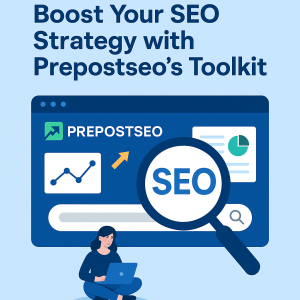
The increase and decrease in search engine ranking are a common factor that every website has to face. However, if your website is not showing any improvement in its ranking despite hours of effort, then you need a better SEO strategy.
And what better way is there to boost SEO strategy than using Prepostseo’s toolkit? Prepostseo is an online platform that offers various tools tailored to boost SEO strategies. With them at your disposal, you can significantly impact your overall search engine ranking.
In this blog, we will discuss different Prepostseo tools that can boost your website’s search engine ranking. So, let’s get started.
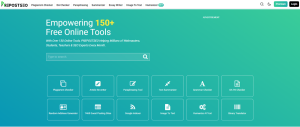
Prepostseo Tools to Boost SEO Strategies
Prepostseo offers a variety of tools that positively impact search engine optimization. Some of the important ones are given below:
Paraphraser Tool

Prepostseo’s paraphrasing tool is an AI-powered one. Its algorithms replace words with synonyms and restructure sentences. Moreover, the paraphrased content does not lose its original meaning.
It is an ideal tool for rephrasing duplicate and low-quality content. Through rephrasing, you can avoid keyword stuffing and improve content readability and uniqueness.
Moreover, the tool has different paraphrasing modes, i.e., standard, fluency, creative, academic, etc. With these, you can convert your content according to readers’ preferences.
Overall, by rephrasing your content to match the reader’s preferences, you can improve your website’s search engine ranking.
Plagiarism Checker

The Prepostseo plagiarism checker is a tool designed to detect duplicate content. It compares your text with content that already exists on the web.
This tool shows the percentage of unique and duplicated content. Moreover, the plagiarism tool highlights any duplicated content and provides a link to the content’s webpage.
Because of this, you can easily find and change duplicated content. You will be able to create unique content that interests readers. And through unique content, you can improve customer engagement and your website’s rank.
Readability Checker

The readability checker of Prepostseo is an online tool that checks the readability score of written content. With this tool, you can write simple and digestible content. This tool divides the content readability score by different grades.
From the lowest score, “college graduate”, to the highest score, “5th grade.” A lower readability score means the content is difficult to digest or understand. While a higher readability score means your content is easy to digest.
With this tool, you can check your content and modify it for a good readability score. A good readability score would bring a response from readers. And this response would be an indicator to search engines through which your website ranking would increase. Hence, this tool is a good choice for content writers.
Keyword Density Checker
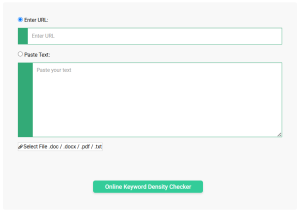
The keyword density checker is another important tool for SEO strategies. With this tool, you can easily check how many times you have used specific keywords. After all, if you repeatedly use specific words in your content, it makes your content feel robotic and lifeless.
Search engines’ algorithms lower the search engine rankings of content with repetitive words. To readers, such content would indicate a lack of detail, making them instantly lose interest.
Keep in mind that keywords are the bridge between readers and your content. Search engines study the keywords to determine what your content is about and then rank your webpage. So, it is a convenient tool for writers to keep their content unique and engaging.
DA PA Checker
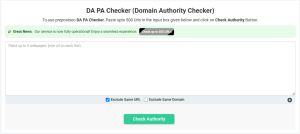
The DA PA Checker by Prepostseo is another valuable tool that can help improve SEO strategies. With this tool, you can check the Domain Authority (DA) and Page Authority (PA) scores. Along with them, it also shows the IP address of the website.
This is a convenient tool through which you can analyze your competitors’ websites. This way, you will be able to identify and make improvements in areas that surpass your competitors.
Moreover, with it, you can assess the quality of your backlinks. Always use high-authority backlinks, as they positively impact your DA/PA.
With the DA PA Checker, you can identify the performance metrics of webpages. Pages with low PA need improvement, while pages with high PA can be your examples for crafting successful content.
Backlink Checker
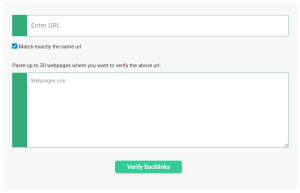
Prepostseo’s backlink checker verifies your website’s backlinks and their effectiveness. With this tool, you can monitor and avoid poor-quality backlinks. Be aware that a website with high-quality backlinks is likely to improve its search engine ranking.
As for backlinks, they are the hyperlinks from one website to another. Backlinks help a search engine recognize the importance of a website’s content. They are like a vote of confidence that determines the value and trustworthiness of a website.
Tools Availability
Accessing the Prepostseo toolkit for SEO strategies is a simple process. Just open the website and start using the tools. Prepostseo offers a cost-free use for its use. Of course, there are certain limits to these tools in free use.
For example, “The plagiarism checker, under free use, allows users to check 1000 words per submission. Similarly, the paraphrasing tool rephrases a maximum of 1000 words per submission.”
However, this is not the limit of Prepostseo’s tools. Prepostseo offers premium plans for all tools. Once you purchase these premium plans, you can increase the limits of these tools.
As for the pricing, Prepostseo offers are divided into two parts. One is the monthly plan, while the other is the yearly plan. These plans are further divided into basic, standard, and company plans. See the image below to understand the plans and pricing of Prepostseo tools:
Monthly Plans:
Yearly Plans:
If you are looking to improve your SEO strategies, then buying a premium account is your best choice. With it, you can constantly use Prepostseo’s SEO-related tools and improve your search engine ranking.
Conclusion
With a slight use of AI tools, you can greatly change your website’s search engine ranking. And that is where Prepostseo’s toolkit comes in handy. It contains all the necessary tools through which you can improve your SEO strategies and make your websites stand out from the rest of your competitors.
Prepostseo, with its 150+ tools, can help you improve your online performance. Moreover, by using its toolkit, you can learn new things that are usually ignored during personal editing. So, stop wasting time and improve your SEO strategies with Prepostseo’s tools.
FAQ’s
Given below are a few of the frequently asked questions that users ask about Prepostseo:
Are Prepostseo tools free to use?
Yes, most of the Prepostseo tools are free to use. However, there are limits to free usage. With premium plans, you can improve these limits and get better features.
Can I use Prepostseo in different languages?
Yes, Prepostseo is an online toolkit that supports multiple languages. It is specifically designed to be accessible to a global audience.
Are the Prepostseo Tools accurate for SEO results?
Yes, Prepostseo’s tools use powerful AI algorithms and a database to generate accurate results. However, it is best to review the results from the AI tools, as they may not be 100% accurate.
Is the Prepostseo tool safe to use?
Yes, the Prepostseo tools are safe to use. No outside party can access your content and personal information. For further guarantee, check out the privacy policy of this toolkit.
Are the Prepostseo tools reliable?
Yes, the Prepostseo tools are reliable tools for SEO-related work. Moreover, because of their reliability and accuracy, they are considered one of the top choices for SEO strategies on a global scale.





















